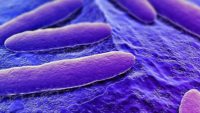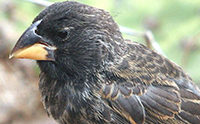By Devon Spencer, DVM Does the difference in eye contact times between domesticated dogs, dingoes, and wolves prove an evolutionary progression from one to another? …read more Source: AIG Daily
While the entire story of evolution faces problems, perhaps its greatest hurdle is answering how life originated. Now a famous piece of research that appeared to shed some light on how life began has been falsified and retracted…and one of its authors was a Nobel Laureate. More… …read more Source: icr.org
By Dr. Ross Anderson Life depends on all three of these elements (oxygen, carbon dioxide, and nitrogen) being in the gaseous form. …read more Source: AIG Daily
A colour mutation that camouflages deer mice against a sandy background is a great example of natural selection. …read more Source: creation.com
By Sarah Eshleman If you could look at a live scallop, you’d see its shell frilled with tentacles and a layer of flesh on the inside rim, edged with little dots—its eyes. …read more Source: AIG Daily
The Polled Dorset breed of sheep did not evolve-its hornlessness is the result of a mutation. …read more Source: creation.com
Cycling engineers constantly seek to make their racing bikes faster and safer. They discovered a unique design in nature and adapted it to bike wheels. This design has an unexpected source. More… …read more Source: icr.org
By Dr. Ross Anderson This article recapitulates some of the many aspects of the element carbon that have clearly been shown to be perfectly matched for life. …read more Source: AIG Daily
By Ken Ham The more we learn about God’s creation, the more we should be moved to worship and stand in awe of him—because his creation is amazing! It seems no matter where researchers look, or what kind of research they do, they discover layer upon layer of complexity. And researchers just discovered another layer of complexity to our brains. Order your Body of Evidence DVD set today! Our brains really are incredible! And the more research that’s done, the more we realize what they are capable of. There’s no way our complex brains could come about by random chance [More]
By Dr. Nathaniel T. Jeanson Recently, a team of scientists from the United States, Canada, and Europe discovered a new species of unusual microbe. …read more Source: AIG Daily
By Dr. Andrew Fabich With the correct biblical worldview in mind, Richard Lenski’s E. coli demonstrate an amazingly complex showcase for design by an all-knowing Creator. …read more Source: AIG Daily
By Avery Foley Real-life examples are increasingly showing the brain (particularly the infant brain) to be much more complex than this simplistic understanding. …read more Source: AIG Daily
(Credit: NASA, H. Richey) It was heralded as decisive proof of the theory of evolution. But Harvard biologist and Nobel Prize laureate Jack Szostak now has retracted a major paper that claimed to explain one of the most important questions about the origin of human life. In 2016, Szostak published a paper claiming he had found…
By Rick Barry A Harvard-trained geneticist shows how new findings have shattered Darwin’s best guesses about the origin of species. …read more Source: AIG Daily
The bald eagle … a powerful, swift and independent creature. …read more Source: creation.com
Pacific salmon are more accurate than guided missiles when it is time to spawn. …read more Source: creation.com
About a dozen species of Darwin’s famous finches inhabit the various Galapagos Islands. Textbooks have long used these animals as examples of evolution. Now, a new finch species established itself as a bona fide population on the tiny island of Daphne Major. What do these new observations imply about textbook evolution? More… …read more Source: icr.org
The ScienceBlogs website indicates intra-abdominal testicles show that elephants may have evolved from a common ancestor of manatees or whales. Many of us remember enjoying coloring books and can recall the connect-the-dot pictures. Looking back from an adult standpoint at what seemed like a fun activity as a kid, now I see an exercise that teaches a child in multiple ways. Having to identify the number one dot and use fine motor skills to draw the line from dot one to dot two and so on, you would continue drawing lines until you got to the last dot. This taught [More]
By Dr. Kevin Anderson The presence of tissue, cells, and proteins remaining in dinosaur fossils poses a direct biochemical challenge to the standard geologic dating paradigm. …read more Source: AIG Daily
The receptacle is ‘expertly crafted’ and ‘delicately made’, but the flowers in it are said to have come about by chance. …read more Source: creation.com
Examining the abundance of variations within creatures after Noah’s Flood. …read more Source: creation.com
Dozens of technical reports show original biochemistry in long-buried fossils, and the reports just keep coming. Three new reports give occasion to reconsider the age assignments for these fossils. The biochemicals they harbor resemble timers that should have elapsed long ago unless these fossils were deposited thousands of years ago, not millions. More… …read more Source: icr.org
Why one atheist’s arguments about pandas don’t stand up to scrutiny. …read more Source: creation.com
Evidence of our Lord’s creativity and attention to detail can be seen throughout his creation, from the large to the very tiny, from the flashy to the drab. All you have to do is open your eyes and look. Here are two examples involving insects you’ve probably seen before but perhaps never thought much about: the water strider and the leafhopper. My, What Beautiful Legs You Have Water striders are a familiar sight on ponds and other bodies of water around the world. Belonging to the family Gerridae are 2,200 species of this insect that is commonly known [More]
Six years ago, a massive 9.0 earthquake rocked the island of Japan, but the worst was yet to come just hours later. Following the earthquake, a 125-foot tall tsunami decimated the Japanese coastline, killing 18,000 people, melting down three nuclear reactors, and washing 5 million tons of debris out to sea, including fishing boats, docks, buoys, and various pieces of wood and plastic. This debris was caught by ocean currents and slowly transported 4,000 miles to coastlines on the other side of the world, including Hawaii and the Pacific coast of North America. Tsunami Voyagers This tsunami debris [More]
Astonishing examples of high intelligence in “lower” animals point to an all-knowing Creator. Truman, an octopus at the New England Aquarium, could see several aquarium workers each day; but he consistently soaked only one college student volunteer with cold salty water. After taking a leave for a few months, the volunteer returned and was promptly soaked again. Truman did not soak anyone else in the interim.1 In the past decade, octopuses have gained a reputation for high intelligence and acute awareness of their environment. They don’t just recognize human helpers, but they plan ahead. Many species will construct [More]


















![He Drew the Line [Live] He Drew the Line [Live]](http://img.youtube.com/vi/qymmptsBcNQ/0.jpg)























